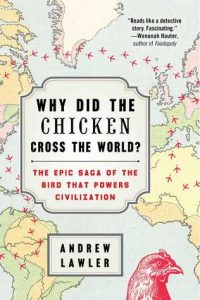 Alright. So which came first? The chicken or the egg? You’ll be able to find the answer to that in here, but this little video in an article from Brain Pickings does a good job, too.
Alright. So which came first? The chicken or the egg? You’ll be able to find the answer to that in here, but this little video in an article from Brain Pickings does a good job, too.
Why Did the Chicken Cross the World? is, as the cover says outright, the “Epic Saga of the Bird that Powers Civilization”. I was pretty surprised even just reading the introduction: the chicken is the most widespread bird globally, which lives in every nook and cranny of the world except for one continent (Antarctica, though empire penguin chicks have caught diseases that come from chickens still) and one state (Vatican City). Once I consider it, it makes sense, but given how widespread they are, shouldn’t we see live chickens running amok a bit more often than we currently do?
The noticeable absence of the (live) bird that most populates the world is a bit concerning, and this is the case just about everywhere unless you happen to work as a butcher or in the poultry industry, and while sermonizing is not what Lawler does in this book (nor is it my intention here!), he does touch upon how little we actually get to see, and therefore think about, the chicken as a bird as opposed to as meat – which in turn means that we also don’t think too hard on how the development of the chicken for larger breasts and more meat for less feed has led to the possibility of chickens that are in perpetual pain throughout their short lives because their skeletal structures are incapable of keeping up with the rapid growth of their bodies. Lawler even describes an episode where roosters took out their frustrations on hens, sometimes killing them, either because their enlarged breasts prevented mating, or because they were unaware of the courting dance. It’s not the first creature we think of when we say this, but perhaps “short, nasty and brutish” should describe the lives of chickens instead – though in truth it’s due to the short, nasty and brutish lives of people!
Anyway. Lawler does a pretty stellar job taking you from place to place as you follow the chicken on its journey from becoming domesticated to becoming found worldwide as he moves from continent to continent and from time period to time period. The irony here is that even as the chicken is becoming ever more widespread and consumed, the Red Jungle Fowl is ever more threatened by pollution of their gene pool due to matings with domesticated chickens, to the point that even though Red Jungle Fowl still exist, there are precious few that have purely wild genes.
A Chicken Followed Me Home! is another chicken-focused book, and this one would be great for children, or even just before tackling a full book about the chicken and how the unlikely candidate that is its ancestor (the Red Jungle Fowl) managed to become as widespread as it did. And now, because we know how the chicken made its way around the world and invaded our lives across the globe, let’s explore a couple of ways to enjoy all that it offers us!
Maybe you think cookbooks shouldn’t be making their way into a series about birds, a series that is a celebration of birds? Well where else should I be exploring cookbooks that teach you how to cook chicken, duck, and other birds, but in a series about avian matters?*
*You wouldn’t be wrong to think so, though, especially in light of Lawler and finding out about the poultry industry’s treatment of chickens. Well those who are able to do so can buy responsibly or raise and slaughter their own to ensure the chicken has been treated humanely prior to slaughter.
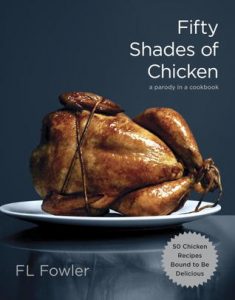 I don’t think I could possibly make any list of chicken cookbooks without including Fifty Shades of Chicken, by F. L. Fowler. It is an absolute delight. Even better, it lives up to every expectation you might have of it based the title!
I don’t think I could possibly make any list of chicken cookbooks without including Fifty Shades of Chicken, by F. L. Fowler. It is an absolute delight. Even better, it lives up to every expectation you might have of it based the title!
Each recipe is accompanied by a short story/chapter parodying Fifty Shades of Grey, and while the photos of the finished chicken dishes look scrumptious, I’ve got to say that the stories are probably the mains of this course, if even just for the fact that they exist at all!
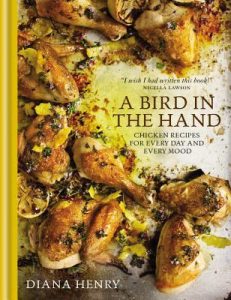 A Bird in the Hand by Diana Henry is a collection of a variety of chicken recipes that should be a perfect fit for anyone’s mood, any day. It’s filled with mouthwatering photos of the recipe results, and I’m not sure about you, but I love a cookbook that puts the finished product in front of my eyes! Knowing how it’s supposed to look makes it that much easier to follow the instructions, personally. While some of these ingredients may not already be in your cupboard, as Henry covers quite a swathe of land when it comes to the recipes’ provenances, but it shouldn’t be too hard to track down most of the ingredients.
A Bird in the Hand by Diana Henry is a collection of a variety of chicken recipes that should be a perfect fit for anyone’s mood, any day. It’s filled with mouthwatering photos of the recipe results, and I’m not sure about you, but I love a cookbook that puts the finished product in front of my eyes! Knowing how it’s supposed to look makes it that much easier to follow the instructions, personally. While some of these ingredients may not already be in your cupboard, as Henry covers quite a swathe of land when it comes to the recipes’ provenances, but it shouldn’t be too hard to track down most of the ingredients.
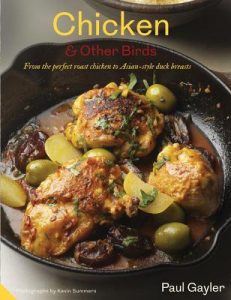 And let’s not forget our other avian friends! Chicken and Other Birds covers more than just chicken, and in a variety of cooking styles, from the still pretty common turkey and goose to guinea fowl, pigeon, and quail! I’m not really sure where you would go to get your guinea fowl, pigeon*, or quail for your dinner, but once you do get your hands on one/some, look no further to learn – with photos & instructions – how to prepare the bird before cooking and how to deal with it after. Gayler also covers what to serve with your poultry (or wild game): flavoured butters – let me repeat, flavoured butters – sauces, dips, and gravy… you’ll never be at a loss again how to cook the next fowl** that ends up at your doorstep!
And let’s not forget our other avian friends! Chicken and Other Birds covers more than just chicken, and in a variety of cooking styles, from the still pretty common turkey and goose to guinea fowl, pigeon, and quail! I’m not really sure where you would go to get your guinea fowl, pigeon*, or quail for your dinner, but once you do get your hands on one/some, look no further to learn – with photos & instructions – how to prepare the bird before cooking and how to deal with it after. Gayler also covers what to serve with your poultry (or wild game): flavoured butters – let me repeat, flavoured butters – sauces, dips, and gravy… you’ll never be at a loss again how to cook the next fowl** that ends up at your doorstep!
*This probably goes without saying, but um… it’s probably inadvisable to go out and catch your own local pigeon for dinner, even if they do appear as though sitting ducks, for reasons, among other reasons.
**I kept typing “fowl” at first for this post, but then realized as I kept reading the books in this Avian Matters series that not all birds are fowl! They only refer to gallinaceous birds, or (domesticated) birds kept for meat & eggs. I suppose every bird in this post could be referred to as fowl, though, seeing as they or their eggs are all getting cooked and eaten.
I believe we’ve covered enough for bird meat preparation, and surely we’d be remiss if we didn’t cover the other contribution to our culinary adventures from chickens & other birds: eggs.
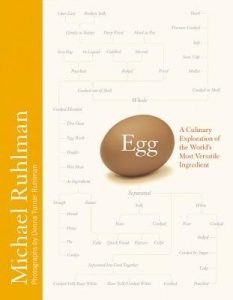 Egg by Michael Ruhlman explores the subject in detail, taking as his starting point the absolute marvel that is the egg and what a magical ingredient it is in the kitchen. Ruhlman starts from the basics of cooking eggs (think scrambled and poached), walking the novice egg cook through working with eggs, before going through what to do with that perfectly scrambled egg. You’ll find recipes dealing with how to prepare the egg to how to use it in baking and cooking, accompanied by beautiful pictures and detailed instructions. There are stories tucked away between recipes, so it’s not all just a cookbook, rather a “culinary exploration of the world’s most versatile ingredient”.
Egg by Michael Ruhlman explores the subject in detail, taking as his starting point the absolute marvel that is the egg and what a magical ingredient it is in the kitchen. Ruhlman starts from the basics of cooking eggs (think scrambled and poached), walking the novice egg cook through working with eggs, before going through what to do with that perfectly scrambled egg. You’ll find recipes dealing with how to prepare the egg to how to use it in baking and cooking, accompanied by beautiful pictures and detailed instructions. There are stories tucked away between recipes, so it’s not all just a cookbook, rather a “culinary exploration of the world’s most versatile ingredient”.
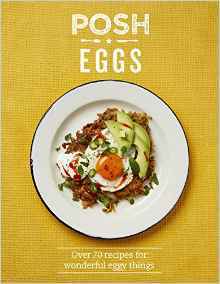 Posh Eggs is great for showing you how to transform the common egg from a gooey mess to a delightful dish in over 70 different ways! Lucy O’Reilly will take you from morning breakfast to your supper at night with eggs, eggs, and more eggs – which might not be the best for your health, but if you’re bored of eating plain scrambled eggs with a pinch of salt and pepper every day for breakfast and want to spice up your morning meal, look no further for inspiration and recipes! Each recipe is accompanied by a photo, and there’s an introductory section that teaches you from the start how to cook eggs, so Posh Eggs is a cookbook for every kitchen skill level!
Posh Eggs is great for showing you how to transform the common egg from a gooey mess to a delightful dish in over 70 different ways! Lucy O’Reilly will take you from morning breakfast to your supper at night with eggs, eggs, and more eggs – which might not be the best for your health, but if you’re bored of eating plain scrambled eggs with a pinch of salt and pepper every day for breakfast and want to spice up your morning meal, look no further for inspiration and recipes! Each recipe is accompanied by a photo, and there’s an introductory section that teaches you from the start how to cook eggs, so Posh Eggs is a cookbook for every kitchen skill level!
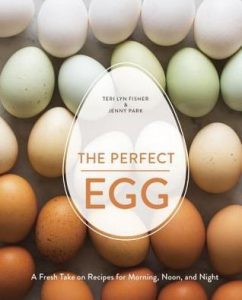 The Perfect Egg will open your eyes to an eggciting new world of what to do with eggs! Yes, I went there; no, I don’t regret it – now keep reading. Teri Lyn Fisher walks you through coddled and poached eggs, where the egg features as the star, to soups and tarts and quiches where the egg plays a variety of different roles. You’ll learn about different grades of eggs, as well as the differences between eggs laid by different fowl, so that you can make a more informed choice next time at the market. Fisher also helps you decode what is printed on egg cartons, and teaches you how to store and handle your eggs once you’ve made your choice.
The Perfect Egg will open your eyes to an eggciting new world of what to do with eggs! Yes, I went there; no, I don’t regret it – now keep reading. Teri Lyn Fisher walks you through coddled and poached eggs, where the egg features as the star, to soups and tarts and quiches where the egg plays a variety of different roles. You’ll learn about different grades of eggs, as well as the differences between eggs laid by different fowl, so that you can make a more informed choice next time at the market. Fisher also helps you decode what is printed on egg cartons, and teaches you how to store and handle your eggs once you’ve made your choice.
Fisher starts from the basics and teaches you the parts of the egg, along with covering a pretty wide array of eggs, from regular chicken eggs to ostrich eggs. That’s right: ostrich eggs. And if you’ve ever wanted to make your own mayonnaise, this is for you. Wondering what a spaetzle is? Or okonomiyaki? Here’s a good place to start! And you can probably make your own mayo for the okonomiyaki, too!
Next time you accidentally purchase too many eggs, you’ll be more than prepared to cook and bake your way through the lot!
Next up on Avian Matters is my personal favourite of the lot, out of the birds I see from day to day: Corvidae. And find below, as always, the list of Avian Matters, past, present and future.
- Why Must Ravens Be Conspiring to Be Unkind?
- Bird Sense
- Why Did the Chicken Cross the World?
- Corvidae
- Birdwatching